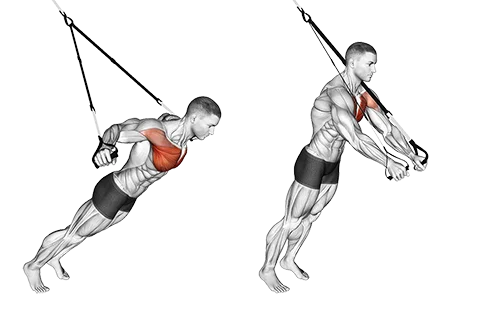Introduction
The "Ring Chest Fly" exercise targets the chest muscles using resistance bands or suspension training systems. It primarily strengthens the pectoralis major muscle group, enhancing upper body strength and definition. This exercise effectively contributes to achieving a well-rounded upper body physique, particularly useful for individuals pursuing fitness goals focused on chest development and functional strength training.
Muscles Worked
- Primary: Chest (Pectoralis Major)
- Secondary: Deltoid (Shoulder), Triceps, Serratus Anterior
How to Do It (Step-by-Step)
- Sit on a bench with dumbbells at your sides, palms facing each other and thumbs wrapped around handles.
- Bend your elbows slightly to keep the dumbbells close to your chest.
- Keeping your upper arms stationary, extend your arms outward in an arc until they are parallel to the ground, squeezing your chest muscles at the top of the movement. Reverse the motion to return to the starting position.
Tip: Maintain a neutral spine throughout the exercise and avoid swinging your torso for added emphasis on chest muscles.
Rep & Rest Guidelines
- Strength: 4–6 reps, 2–3 min rest
- Hypertrophy: 8–12 reps, 60–90 sec rest
- Endurance: 12–20 reps, 30–60 sec rest
For efficient progression in your workouts, check out Auto Progression and never miss a rep or set again!
To optimize your rest periods between sets, consider using the built-in Rest Timer in Volym App.
Form Tips
- Maintain a neutral grip by holding the dumbbells with an overhand or underhand grip, keeping your palms facing each other.
- Keep your back straight and core engaged throughout the exercise to avoid any strain on your lower back.
- Position the dumbbells at chest level, slightly wider than shoulder-width apart, and move them in a controlled manner, focusing on contracting your chest muscles rather than swinging the weights.
When to Use It
- Strengthening upper body for swimming and rowing sports
- Improving postural balance in a mixed-exercise routine
- Enhancing pectoral muscles for bodybuilding workouts
Training different muscle groups is essential to maintain overall fitness. Workout History helps you track and monitor your progress effectively.
The ring chest fly primarily targets the chest muscles, specifically the pectoralis major and minor muscles.
Rings provide instability during the exercise, which challenges your core and stabilizer muscles, resulting in a more functional and well-rounded workout.
Start with a weight that allows you to perform the exercise comfortably for 12-15 repetitions. Gradually increase the weight as your strength improves.
Maintain a tight core, avoid arching your back, and keep your wrists straight throughout the exercise. Lower the rings to slightly below chest level before pushing them back up.
You can perform ring chest fly on both benches and the floor, but using a bench allows you to isolate your chest muscles more effectively since it reduces the involvement of your core and stabilizer muscles.

